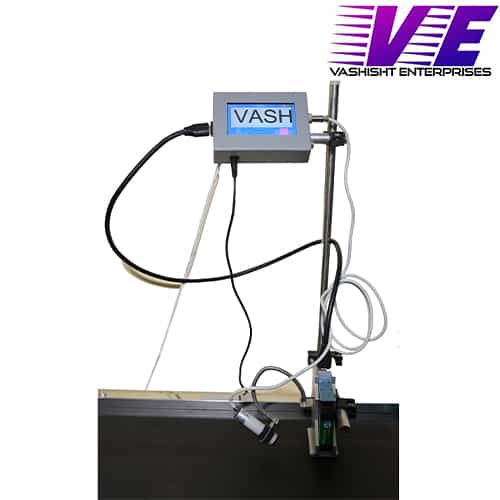
Best Thermal Inkjet Printers & Machines Exporter in Delhi NCR
In the industrial landscape of Delhi NCR, the whir of production lines and the beat of packaging floors normally come together around one technology: thermal inkjet printers . They are the go-to machines for printing expiry dates on medication, batch numbers on packs of food, embossing logos on cosmetics, or coding barcodes for logistics. A good exporter in Delhi NCR of quality printing machines knows that the worth is not only in the machine you purchase, but also how proficient it is for your particular requirement.
This article discusses what makes highâquality printing machines stand out, why thermal inkjet technology has emerged as the favored one in new production, what purchasers are looking for, and how to select a vendor you can trust.
Why Thermal Inkjet Printers Are Important
First of all, why are thermal inkjet printers a good option in so many industries?
- High accuracy and sharpness
These units are capable of producing fine, sharp prints — clean text, barcodes, logos — without much smudging. The process heats small droplets of ink and squirts them onto the page with great accuracy, which creates sharp edges and uniform output. - Substrate versatility
They work not just on paper, but also on plastics, laminates, flexible films, metal surfaces, curved containers, etc. This flexibility is valuable across industries like pharmaceuticals, food & beverage, cosmetics, and packaging. - Reduced maintenance
With fewer mechanical moving parts compared to some other printing types, less wear and fewer breakdowns happen. That often translates into lower operating interruptions and less time spent troubleshooting. - Rapid startâup and integration
Thermal inkjet printers usually need minimal warmâup time, which makes them great for production environments where you change print jobs frequently. Their electronic controls and small size make it simple to integrate into production lines or packaging sequences. - Cost effective in the long run
While the initial price may be higher than for more basic printers, the costs—ink usage, waste, downtime—are reduced. At scale or in continuous operation, the savings compound.
What Makes a Quality Printing Machine
When looking for quality printing machines, these are features and performance considerations you should consider:
- Print resolution and speed: Dot density per inch (dpi) counts for readability, particularly for tiny print such as batch numbers or barcodes. And speed counts too—both in how quickly it prints and how quickly it recovers between prints.
- Ink type and durability: Inks need to be suitable for the substrate and application environment. Some need water resistance, UV stability, smudge resistance, etc.
- Reliable build and robustness: Robust printheads, solid components, dustproofing, waterproofing, anti-vibration. Industrial environments are rough, and machines designed for them withstand longer.
- User-friendliness and control panel: Simple-to-use control panels, diagnostics like nozzle clogging, ease of parameter tweaking, little or no user training required.
- Spare parts & consumables: Cartridges, printheads, spares should be readily available. Spares delay equates to downtime and production loss.
- Afterâsales support: Whether local or remote, good support ensures the machine remains productive. Documentation, training, troubleâshooting help make a difference.
- Export credentials: Proper packaging, certifications (electrical, safety, environmental), understanding of customs and international compliance all matter if you’re importing machines from NCR.
BuyerâDemands & Current Trends
Here are what modern buyers increasingly ask for:
- Energy efficiency & eco-friendly inks: Need for lowâVOC or nonâtoxic inks, recyclable or safer materials, and more energyâefficient designs.
- Intellectual features: Detection of clogging by sensors, automatic control of ink feed, remote monitoring, predictive maintenance, connectivity with production software.
- Enhanced substrate compatibility: Capability to print on different materials reliably without requiring unwarranted adjustments or special preâtreatment.
- Expandable or scalable systems: Machines that are easily expandable, or where print heads or modules can be replaced or inserted for increased throughput.
- Simple maintenance & minimal downtime: Consumers prefer machines that are easy to maintain, clean, and service without extended periods of breaks in production.
What to Look Out for Before You Buy
Below is a checklist to help you when selecting a manufacturer/exporter for thermal inkjet machines:
- Define your printing needs
What material are you printing onto? How long does the print have to last? What size are the prints? How often are you printing? What rate of speed do you need? - Inspect sample outputs
Request sample prints on your real packaging or substrate. Observe how they appear, how nicely they stick, how they withstand environment (humidity, washing, abrasion). - Evaluate overall cost of ownership
Consider not only machine price, but consumables, maintenance, electricity, downtime, parts replacement etc. - Check build and reliability
Functional machines made from robust material, adequate protection, reliable electronics, tough build. - After-sales & spare availability
How readily can parts be supplied? Is service assistance available locally? What guarantee is offered? - Export readiness
Make sure the exporter gets proper packaging, documentation, safety certifications, and that the machine has the ability to conform to standards in your area. - Environmental and regulatory compliance
For most industries (food, pharma etc.), labeling needs to adhere to regulatory norms. And inks and materials might have to conform to standards on safety and environment.
Pros & Cons of Thermal Inkjet Printers
Understanding both sides helps you make a well-informed decision.
Pros
- Superior print quality for small text, logos, barcodes.
- Lower maintenance as there are fewer moving parts.
- Will print on a wide variety of substrate types, including curved or irregular surfaces.
- Energy conserving or more costâeffective in the long run.
Cons
- Some environmental sensitivity (heat, humidity) can impact print durability.
- Specialty inks can be necessary, which might be more expensive or more difficult to acquire.
- Certain equipment is not well suited for very high-volume continuous print versus other technology.
FAQs
1. What DPI resolution is best for printing barcodes and batches?
300â600 dpi is typically enough for readable, clear barcodes and batch numbers. Greater density (dpi) is useful when printing tiny font or detailed logos. Scanning/barcode reading will not work if you go too low.
2. Will thermal inkjet prints withstand water exposure, washing, or chemicals?
Depends on substrate and ink formulation. Some inks are solventâbased or waterâresistant and intended for more rugged environments. Always test with your real conditions prior to full deployment.
3. How long do printheads last?
With appropriate maintenance, cleaning, and compatible ink, printheads have a life span of many thousands of hours. But extreme usage, severe conditions, or incompatible ink can cut it short drastically.
4. Is maintenance hard or expensive?
In contrast with some other printing technologies, maintenance is easier and less frequent. But expense relies on parts such as printheads, inks, and spare parts availability. Good support and design bear heavily.
5. What certification or documentation should I request if importing one?
You should obtain documentation on electrical safety, CE / BIS / UL or appropriate safety standards for your nation, environmental compliance (if necessary), packaging that assures safe transit, warranty documents, and user & maintenance manual.



